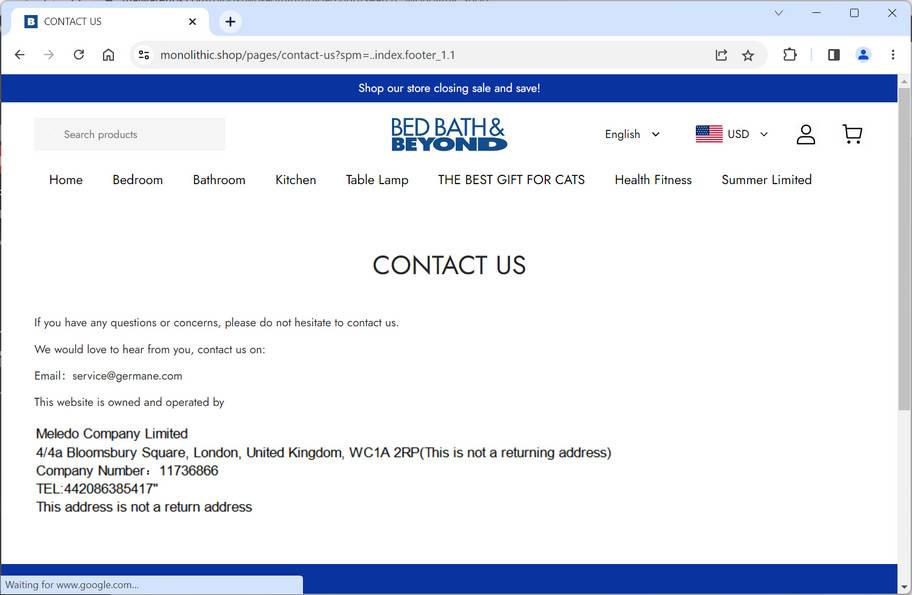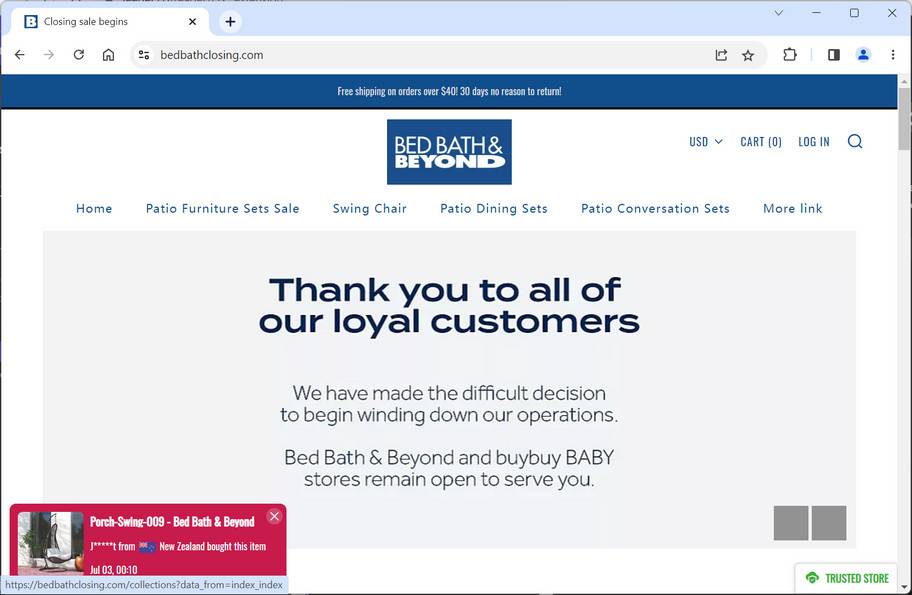If you are a fan of Bed Bath & Beyond, you might have seen some ads or emails claiming that the store is closing and offering huge discounts on everything. But before you rush to buy anything, you should be aware that this is a scam that could cost you money and expose your personal information.
This Article Contains:
What is the Bed Bath & Beyond fake online shopping sites scam?
The Bed Bath & Beyond fake online shopping sites is a scam that involves creating fake websites that look like the official Bed Bath & Beyond website, but have different domain names. These websites claim to offer huge discounts on various products, such as bedding, bath accessories, kitchenware, and home decor. They also use the Bed Bath & Beyond logo and other branding elements to make them appear authentic.
The scam targets consumers who are looking for bargains and who may not pay attention to the details of the website they are visiting. The scammers lure them in with catchy headlines, such as “Store closing sale! All stores closing” or “Everything must be sold! New merchandise is arriving often so come back see our latest selection”. They also use fake reviews, testimonials, and social media posts to create a sense of urgency and trust.
How does the Bed Bath & Beyond fake online shopping sites scam work?
The Bed Bath & Beyond fake online shopping sites scam works by tricking consumers into placing orders on the fake websites, using their credit card or other payment methods. The scammers then collect the money and either send nothing at all, or send products that are different from what was ordered, such as cheap knock-offs, damaged goods, or items that do not match the description or photos.
The scammers behind the Bed Bath & Beyond Fake Online Shopping Sites Scam use various techniques to trick customers into visiting their fake websites and entering their personal information. Some of these techniques are:
- Sending spam emails that look like they are from Bed Bath & Beyond, with subject lines such as “Store closing sale! all stores closing”, “Everything must be sold!”, or “New merchandise is arriving often”. The emails contain links to the fake websites, where customers are prompted to shop and check out.
- Creating fake social media accounts or pages that pretend to be affiliated with Bed Bath & Beyond, and posting ads or messages that promote the fake websites and their discounts. The scammers may also use bots or paid followers to like, comment, or share their posts, making them appear more legitimate and popular.
- Buying online ads on search engines or other websites that display the Bed Bath & Beyond logo and name, and direct customers to the fake websites when they click on them.
- Registering fake domain names that are similar to the real one, and using them to host the fake websites. The scammers may also use typosquatting or URL shortening services to hide the true domain name of their fake websites.
The consumers who fall victim to this scam may not realize that they have been scammed until they receive their order confirmation email, which may have a different domain name than the website they visited, or until they try to track their order status, which may not exist or show no progress. By then, it may be too late to cancel their order or request a refund.
The scammers may also use the consumers’ personal and financial information for identity theft or other fraudulent activities. They may sell their data to other scammers, hackers, or cybercriminals, who may use it to access their accounts, open new lines of credit, or make unauthorized purchases.
How to avoid the Bed Bath & Beyond fake online shopping sites scam
The Bed Bath & Beyond fake online shopping sites scam is a serious threat to consumers who shop online. It is important to be aware of this scam and how to avoid it. Here are some tips to help you protect yourself from this and other online shopping scams:
- Always check the domain name of the website you are visiting. Make sure it matches the official website of the company you want to buy from. For example, the official website of Bed Bath & Beyond is https://www.bedbathandbeyond.com/, not https://www.bedbathandbeyond.store/ or https://www.bedbathandbeyond.sale/.
- Always look for signs of security and legitimacy on the website you are visiting. Look for a padlock icon in the address bar, which indicates that the website uses encryption to protect your data. Look for contact information, such as a phone number, email address, or physical address, which you can use to verify the identity of the company. Look for customer service policies, such as return and refund policies, shipping and delivery information, and privacy policies, which should be clear and transparent.
- Always do your research before buying from a new or unfamiliar website. Read reviews and ratings from other customers who have bought from the website. Check if there are any complaints or reports of fraud against the website on consumer protection websites, such as the Better Business Bureau or Scamwatch. Compare prices and products with other reputable websites to see if they are realistic and consistent.
- Always use a secure and trusted payment method when buying online. Avoid using direct bank transfers, wire transfers, money orders, or prepaid cards, which are difficult to trace and recover if something goes wrong. Use a credit card or a third-party payment service, such as PayPal or Apple Pay, which offer more protection and dispute resolution options in case of fraud.
- Always monitor your bank statements and credit reports regularly for any suspicious or unauthorized transactions. If you notice any signs of fraud, report them immediately to your bank or credit card company and request a chargeback if possible. You can also report the scam to your local authorities and consumer protection agencies.
What should you do if you have shopped from a fake Bed Bath & Beyond site?
- Contact your bank or financial institution: If you have paid with your credit card or debit card, you should contact your bank or financial institution as soon as possible and request them to cancel the transaction and refund your money. You should also report Layny.com as a fraudulent site and ask them to block any future charges from it.
- Change your passwords: If you have created an account on Layny.com or used the same password for other online accounts, you should change your passwords immediately. You should also enable two-factor authentication for your accounts if possible. This will prevent hackers from accessing your accounts and stealing your personal information.
- Beware of phishing emails: You might receive emails from Layny.com or other sources claiming to be related to your order or offering you discounts or refunds. These emails are likely to be phishing attempts that aim to trick you into clicking on malicious links or downloading attachments that can infect your device with malware or steal your information. You should delete these emails and do not open any links or attachments from them.
- Use a browser-based content blocker, like AdGuard : Content blockers help stop malicious ads, Trojans, phishing, and other undesirable content that an antivirus product alone may not stop.
- Scan your device for malware. If you suspect your device is infected with malware, you can run a scan with Malwarebytes Anti-Malware Free.
Conclusion
The Bed Bath & Beyond Fake Online Shopping Sites Scam is a serious threat that could cost you money and compromise your identity. To avoid falling victim to this scam, you should always be careful when shopping online and follow these tips:
- Do not click on any links or open any attachments from unsolicited emails or messages that claim to be from Bed Bath & Beyond or any other retailer.
- Do not trust any ads or posts that offer too-good-to-be-true deals on products from Bed Bath & Beyond or any other retailer.
- Always check the domain name of the website you are visiting and make sure it matches the official one. The official website of Bed Bath & Beyond is https://www.bedbathandbeyond.com/.
- Always look for signs of security and legitimacy on the website you are visiting, such as a padlock icon in the address bar, a valid SSL certificate, clear contact information, and customer reviews.
- Always use a secure payment method when shopping online, such as a credit card or PayPal, and monitor your bank statements for any suspicious charges.
- If you suspect that you have been scammed by a fake website, report it to your bank, your credit card company, and the Federal Trade Commission (FTC) at https://reportfraud.ftc.gov/.












